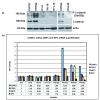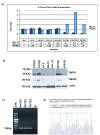Beta catenin and cytokine pathway dysregulation in patients with manifestations of the "PTEN hamartoma tumor syndrome"
- PMID: 22520842
- PMCID: PMC3353236
- DOI: 10.1186/1471-2350-13-28
Beta catenin and cytokine pathway dysregulation in patients with manifestations of the "PTEN hamartoma tumor syndrome"
Abstract
Background: The "PTEN hamartoma tumor syndrome" (PHTS) includes a group of syndromes caused by germline mutations within the tumor suppressor gene "phosphatase and tensin homolog deleted on chromosome ten" (PTEN), characterized by multiple polyps in the gastrointestinal tract and by a highly increased risk of developing malignant tumours in many tissues. The current work clarifies the molecular basis of PHTS in three unrelated Italian patients, and sheds light on molecular pathway disregulation constitutively associated to PTEN alteration.
Methods: We performed a combination of RT-PCR, PCR, sequencing of the amplified fragments, Real Time PCR and western blot techniques.
Results: Our data provide the first evidence of β-catenin accumulation in blood cells of patients with hereditary cancer syndrome caused by germ-line PTEN alteration. In addition, for the first time we show, in all PHTS patients analysed, alterations in the expression of TNFα, its receptors and IL-10. Importantly, the isoform of TNFRI that lacks the DEATH domain (TNFRSF1β) was found to be overexpressed.
Conclusion: In light of our findings, we suggest that the PTEN pathway disregulation could determine, in non-neoplastic cells of PHTS patients, cell survival and pro-inflammatory stimulation, mediated by the expression of molecules such as β-catenin, TNFα and TNFα receptors, which could predispose these patients to the development of multiple cancers.
Figures



References
Publication types
MeSH terms
Substances
LinkOut - more resources
Full Text Sources
Molecular Biology Databases
Research Materials

